Items
Tag
oil paintings
-
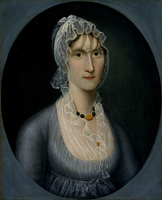 Portrait of Mrs. Barbara Baker Murphy (Wife of Sea Captain) Joshua Johnson, a self-trained artist and former slave, is the earliest documented professional African American painter. His sitters were Captain John Murphy and his wife, Irish immigrants who lived in Baltimore, where Johnson painted many merchants, seamen, and their families. In these portraits--intended to hang side-by-side--the artist delighted in fine details, from the captain's artfully arranged curls to his wife's sheer lace collar.
Portrait of Mrs. Barbara Baker Murphy (Wife of Sea Captain) Joshua Johnson, a self-trained artist and former slave, is the earliest documented professional African American painter. His sitters were Captain John Murphy and his wife, Irish immigrants who lived in Baltimore, where Johnson painted many merchants, seamen, and their families. In these portraits--intended to hang side-by-side--the artist delighted in fine details, from the captain's artfully arranged curls to his wife's sheer lace collar. -
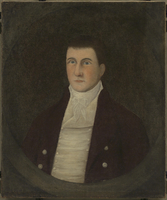 Portrait of John Westwood An oil painting portrait of John Westwood, painted in conventional English portrait style of formal, bust-length pose and arranged backdrop. It depicts a half-length male figure wearing a brown coat with silver buttons and white waistcoat against a dark background. The figure is clean shaven with short brown hair, and is encircled by a faux oval frame. Painted as part of the composition, the oval frame is slightly lighter in color than the background. (Smithsonian Collections Search Center)
Portrait of John Westwood An oil painting portrait of John Westwood, painted in conventional English portrait style of formal, bust-length pose and arranged backdrop. It depicts a half-length male figure wearing a brown coat with silver buttons and white waistcoat against a dark background. The figure is clean shaven with short brown hair, and is encircled by a faux oval frame. Painted as part of the composition, the oval frame is slightly lighter in color than the background. (Smithsonian Collections Search Center) -
 Portrait of Adelia Ellender Adelia Ellender lived in Baltimore, Maryland, where her father was a plasterer. Her dress follows the custom in this period of portraying children as miniature adults. The berries in her hand and the butterfly hovering in a rosebush nearby symbolize not only her childhood innocence but her eventual transformation into a lady
Portrait of Adelia Ellender Adelia Ellender lived in Baltimore, Maryland, where her father was a plasterer. Her dress follows the custom in this period of portraying children as miniature adults. The berries in her hand and the butterfly hovering in a rosebush nearby symbolize not only her childhood innocence but her eventual transformation into a lady -
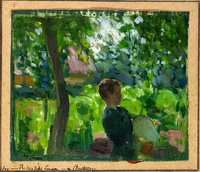 The Bagpipe Lesson This study shows a boy practicing the bagpipe, but for the final version, Henry Ossawa Tanner added a teacher and two more figures. Bagpipe players were common in the French region of Pont-Aven and Concarneau, where Tanner spent his summers in the 1890s. Here, he used bold colors and loose brushwork to capture the scene. Tanner entered a finished version in the annual Paris exhibition, but it was rejected; the Pennsylvania Academy of the Fine Arts, however, accepted it for their yearly show. (Smithsonian Collections Search Center)
The Bagpipe Lesson This study shows a boy practicing the bagpipe, but for the final version, Henry Ossawa Tanner added a teacher and two more figures. Bagpipe players were common in the French region of Pont-Aven and Concarneau, where Tanner spent his summers in the 1890s. Here, he used bold colors and loose brushwork to capture the scene. Tanner entered a finished version in the annual Paris exhibition, but it was rejected; the Pennsylvania Academy of the Fine Arts, however, accepted it for their yearly show. (Smithsonian Collections Search Center) -
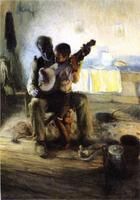 The Banjo Lesson
The Banjo Lesson -
 Romantic Landscape
Romantic Landscape -
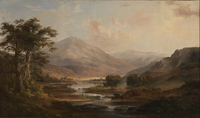 Scottish Landscape Robert S. Duncanson made several trips to Scotland, probably inspired by his father's Scottish heritage. He created romantic wilderness views that may have been influenced by the novels and poems of Sir Walter Scott. In this piece the warm colors and rich vegetation make a remote scene appear welcoming, and would have appealed to the sentimental tastes of his American patrons.
Scottish Landscape Robert S. Duncanson made several trips to Scotland, probably inspired by his father's Scottish heritage. He created romantic wilderness views that may have been influenced by the novels and poems of Sir Walter Scott. In this piece the warm colors and rich vegetation make a remote scene appear welcoming, and would have appealed to the sentimental tastes of his American patrons. -
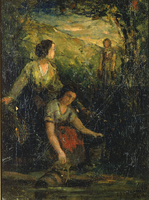 The Drinking Pool (three women at the water)
The Drinking Pool (three women at the water) -
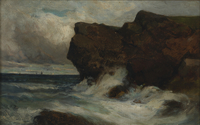 Ocean Cliffs
Ocean Cliffs -
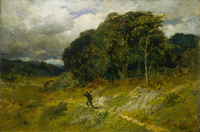 Approaching Storm This windy scene of a lone figure struggling in the face of a storm would have held special meaning for nineteenth-century viewers, who believed that their nation's landscape was infused with God's presence. In 1886, the year he painted Approaching Storm, Edward Mitchell Bannister wrote an essay titled "The Artist and His Critics," in which he argued that spiritual expression is the artist's ultimate goal. (Hartigan, Sharing Traditions, 1985)
Approaching Storm This windy scene of a lone figure struggling in the face of a storm would have held special meaning for nineteenth-century viewers, who believed that their nation's landscape was infused with God's presence. In 1886, the year he painted Approaching Storm, Edward Mitchell Bannister wrote an essay titled "The Artist and His Critics," in which he argued that spiritual expression is the artist's ultimate goal. (Hartigan, Sharing Traditions, 1985) -
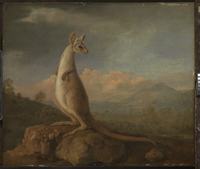 The Kongouro from New Holland A small kangaroo perched on a rock in left profile but looking back over its left shoulder, with a valley of light scrub behind backed by mountains and a cloudy sky.
The Kongouro from New Holland A small kangaroo perched on a rock in left profile but looking back over its left shoulder, with a valley of light scrub behind backed by mountains and a cloudy sky. -
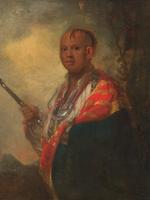 Portrait of Syacust Ukah, 1762
Portrait of Syacust Ukah, 1762